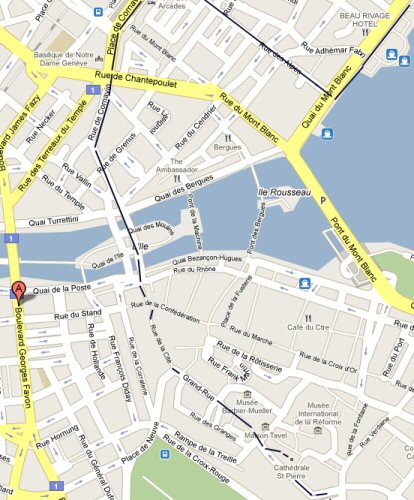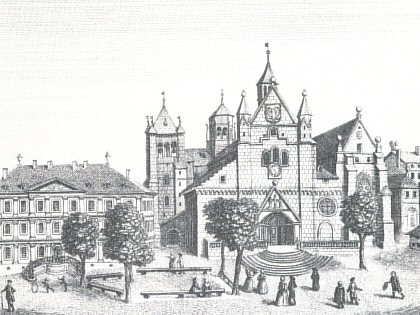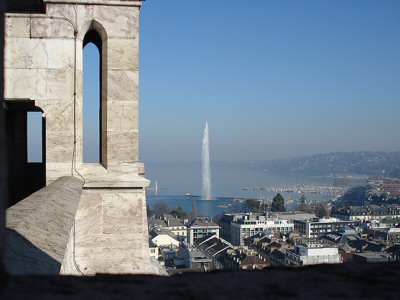Opposite the Hotel Beau Rivage there is a
Memorial to Empress Elisabeth of Austria
In the vicinity she was murdered. Her last resting place is in the Capuchin crypt in Vienna next to Franz Josef.
On the trail of the pilgrims through the city of Geneva [1]

The walk in the footsteps of the pilgrims to Santiago through the city of Geneva begins on the square in front of the Cornavin station, built in 1850. The name Cornavin comes from an inn and vineyards that the bishop owned here, in front of the northern city gate. Originally Corne à Vin [wine cornucopia], the word became Cornavin.
Church of Notre-Dame
After the demolition of the Geneva city fortifications (1842-1846), the vacated site was put to new uses. The Catholics were awarded the former Cornavin bastion, built in 1546, and built the neo-Gothic church of Notre-Dame there. It became Geneva's most important Catholic church.
Coutance is a verbally horned name form of Konstanz. At the lower end of the street was the Hostel zum Weissen Kreuz, founded in 1472. The Rue de Coutance, once the commercial artery of Saint-Gervais, changed its character in 1826 when the 16 wooden domes that protected the shop windows were demolished.
Pont de l’Ile

The importance of the island in the middle of the Rhone for the crossing of the river is well known. The first river crossing was built by the Celts; it was destroyed by Caesar's troops in 58 BC. The Romans built a second bridge on the same site. In the late Middle Ages, there was a wooden bridge with houses on it; in the 16th century, due to the increasing traffic, a second bridge was added upstream. Today, modern concrete bridges connect Geneva, which is divided by the Rhone.
Between 1215 and 1219, a castle was built to protect the bridge over the Rhone to reinforce the city's fortifications. The purpose of the castle was to control the traffic. The castle was named after the two river islands Château de l'Ile. Pilgrims found accommodation on the bridge at the "Bourdon" inn.
In the 17th century, the dwellings, shops and workshops - the trades relied on water power - formed a separate quarter on the bridges. In 1670 it was almost completely destroyed by fire. During reconstruction, the existing square was extended. The new urban space was named Place Bel-Air.

Place Bel-Air
The square used to be named after the inn "Three Kings" first mentioned in 1445, which was located on the site of the present CS bank building. The square was once home to a chapel, Notre-Dame du Rhône (Bridge), where travellers stopped for a prayer. Bankers replaced it in the 14th century with the richly decorated Florentine chapel. Two hospices stood on the site: the Hospice of St James with its chapel, founded in the 14th century, and the Hospice Notre-Dame du Rhône (Pont), founded in 1350.
Rue de la Cité
The street name "Carreria Civitatis" indicates that the connection between the Rhone bridge and the city centre was originally outside the city walls
.
Grand’Rue
The Grand'Rue, which had different names depending on the section, follows the course of the old Roman road.
The narrowing of the rue de l'Hôtel-de-Ville indicates the place where the gate to the bishop's castle, demolished in 1320, stood until 1841. The former armoury opposite the town hall dates back to a covered hall dating from the early 15th century.

Town hall
From the beginning of the 15th century until the Reformation, the town hall was the seat of a municipal government with limited powers. From 1535 it served as the seat of the republican authorities. After 1488, the present Council of State Hall on the upper floor was decorated with Gothic murals. The rue du Soleil-levant takes its name from an inn that was very famous in the Middle Ages. This stood opposite the former armoury, on the corner of rue du Puits-St-Pierre.

At the armoury we turn left on the way to the cathedral.
Cathedral St-Pierre


In the Middle Ages, Geneva was a prince-bishopric of the Holy Roman-German Empire. It reached its heyday in 1450, when Geneva became the most important trade fair centre in Europe.
During the confusion of the Reformation the cathedral was renamed "St. Peter's Temple". The church was robbed of its liturgical institutions, its sacred images, its gold and its princely pomp. But the walls were preserved.
The 12th century cathedral was built on the site of a 4th century basilica over a Roman temple complex in Gothic style. Its foundations are located under the cathedral.
The building from the 12th-13th century closely follows the plan of the previous building. The ground plan and furnishings are partly still Romanesque. The cathedral consists of a five-bay main nave, side aisles and a projecting transept with four chapels framing the front choir and apse.

This is what the church looked like in its Gothic form before the classicist temple front was built. Perhaps the original form will be restored once again?
The 15th century stained glass windows of the choir depict Saints Peter, Paul, Mary-Magdalene, John the Evangelist and the pilgrim patron saint James the Elder, wrapped in a purple cloak trimmed with ermine, with the attributes of pilgrim's staff and shell.
The choir stalls, built in the 19th century, probably originate from the former Franciscan monastery on the shore (Rive). James the Elder is depicted with sandals on his feet, pilgrim's hat and shell. In one hand he carries a book, in the other a pilgrim's staff.
For a larger view of the complete window click on the picture!
Place du Bourg-de-Four
The centuries-old square is situated at the crossroads of the great imperial roads towards Milan via Annecy and towards Vienne-en-Dauphiné via Seyssel. From 1290 the square was used as a cattle market. In the 11th century, the Bourg-de-Four had increasingly transformed into a suburban market quarter. Soon, inns, hostels and inns were established. In the heyday of the 13th century, there is evidence that there were at least a dozen catering establishments around the square. Examples include:
La Coquille (No. 21): The inn with the scallop as its distinguishing feature was the first port of call for travellers.
Opposite was the Pomme d'or. Le Griffon: The mythical creature, half lion, half eagle, was regarded in the Middle Ages as a symbol and landmark of Christ's double nature - human and divine. Le Chêne (Oak): In the Middle Ages, the oak was considered a symbol of hospitality. La Chemise Blanche: The name recalled the radiant white robe of Jesus at the Transfiguration.

View of Geneva and the lake from the cathedral.

Here we sit with a well-deserved coffee or beer and celebrate the end of our hike. Vis-à-vis, the St. James Way sign points in the direction of Santiago.
[1] Source: Magazine "Ultreïa" of the Friends of the Way of St. James, Switzerland No 42; Author: Adrien Grand, Translation: DeepL.com


